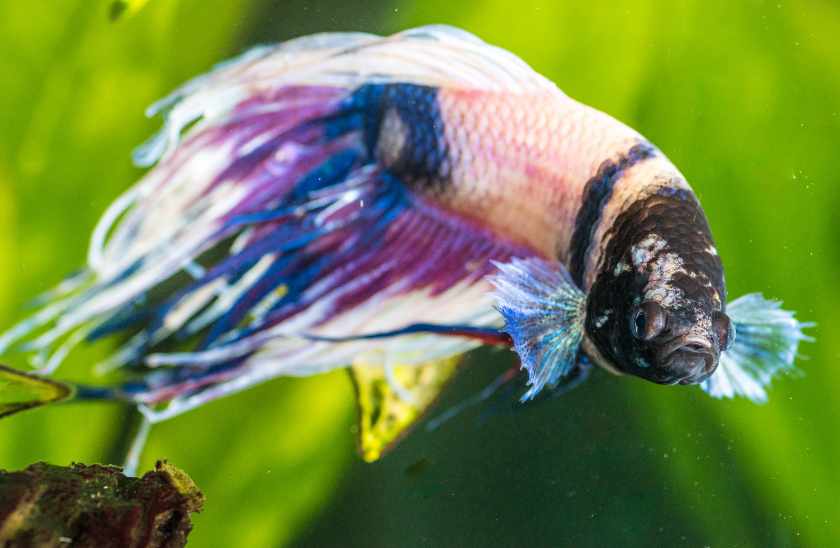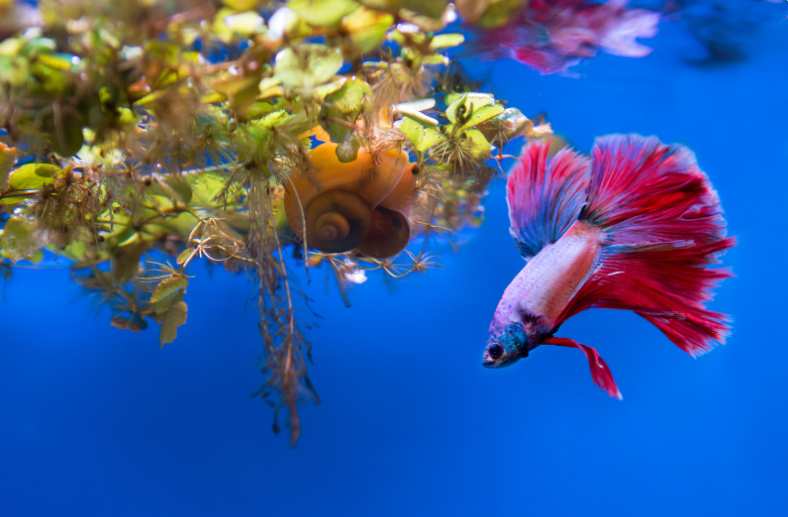The Effects of Temperature Shock on Betta Fish
Temperature shock is critical, and sudden changes can shock and stress betta fish. Caring for your pet Betta fish requires learning about its health and well-being. While Bettas are relatively easy aquarium fish to maintain, providing the right water conditions is crucial. Bettas’s ideal water temperature range is 78-82°F (25-28°C). Exposing a Betta to temperatures outside this range can inflict serious harm, known as temperature shock.
Bettas rely entirely on the water temperature and cannot independently regulate their internal body temperature. Sudden changes in water temperature of more than 2-3°F from the ideal range can shock a Betta’s system. Cold water below 72°F causes “lethargy, inactivity, loss of appetite and clamped fins.” Warm water above 86°F leads to rapid breathing, inflammation, and disease susceptibility. Prolonged exposure to extreme cold or heat just a few degrees beyond the Betta’s tolerance zone can even be fatal within hours.

When confronted with temperature shock, watch for telltale signs in your Betta, like “sluggishness, labored breathing, discoloration, and frayed fins.” Immediately test and adjust the water to return it to 78-82°F to restore healthy conditions. With prompt action, most Bettas will bounce back quickly from a temperature scare. Be vigilant and always maintain the ideal water temperature to keep your Betta active and vibrant. Stable conditions prevent shock and lead to a long, healthy life for this splendid fish.
Table of Contents
- What Is A Temperature Shock?
- Main Causes Of Temperature Shock
- Cold Temperature Shock Signs and Symptoms
- Hot Temperature Shock Signs and Symptoms
- Can Betta Recover From A Temperature Shock?
- How To Avoid A Temperature Shock?
- Conclusion
What Is A Temperature Shock?
A temperature shock occurs when a sudden, significant change in the water temperature exceeds a Betta fish’s ability to adapt. As ectotherms that rely on ambient water to regulate their body temperature, Bettas are highly sensitive to fluctuations outside their ideal 78-82°F range. Bettas fish’s body react similarly to how humans experience hypothermia or heat stroke when core temperature drops or spikes.
More extreme temperature swings of 10°F or greater can prove lethal in less than an hour as organs begin to fail. The shock inflicts severe physiological stress as tissues and enzymes destabilize. Oxygen exchange is disrupted, hormones fluctuate wildly, and fluid balance is lost. Bettas essentially suffocate as their bodies shut down. Rapid intervention is required to prevent death.
While occasional minor fluctuations are tolerated, sudden shifts can seriously threaten a Betta’s health. Careful monitoring and quick correction of water temperature is crucial. With sensitivity exceeding that of humans, even minor deviations from their comfort range can induce temperature shock and distress in Bettas. Stability is key to avoiding this dangerous condition. Here are some common causes of temperature shock in more detail.
Main Causes Of Temperature Shock
Any fluctuations outside the tank water range can induce dangerous temperature shocks. Here are some typical scenarios that prompt sudden temperature changes leading to shock.
- Room Temperature Changes
Betta tanks are impacted by ambient air temperature. Heat waves over 86°F or cold snaps under 70°F can raise or lower water temperature beyond safe limits within hours. Small tanks are especially vulnerable to room temperature swings.
- Water Changes
Replacing tank water with new water more than 2-3°F different from the tank can instantly drop or spike temperatures if not done gradually. Constantly adjust replacement water to match tank temperature.
- Moving Fish
Transferring a Betta between containers with different water temperatures causes immediate shock if not acclimated. Float the fish in a bag for 30 minutes to equalize temperatures before slowly adding tank water.
- Equipment Failure
A heater or chiller failure can rapidly alter water temperature. Have a backup plan to maintain stable conditions if equipment stops working.
- Seasonal Changes
Tanks located near windows or vents may cycle between hot and cold seasons. Watch conditions closely and supplement stability as needed.
- Sudden Weather Changes
Abrupt cold fronts or heat waves can impact room and water temperature faster than a Betta can adjust.
With vigilance and contingency preparation, these common shock causes can be avoided. Monitor conditions and gradually adjust to sustain a stable, comfortable temperature range. Quick action when fluctuations occur will help prevent temperature shock in Bettas.
Here are some common symptoms of cold temperature shock in Betta fish. Here, we will explain what happens during temperature shock, list the common symptoms, and advise on treatment when it occurs.
Cold Temperature Shock Signs and Symptoms

01. Lethargy – Affected Bettas become sluggish and inactive as their metabolism slows in cold water. They stop swimming around and rest motionlessly on tank surfaces.
02. Loss of Color – Cooler water washes out Betta’s vibrant colors. Bright red and blue hues pale and fade as proteins and pigments destabilize. Dark stress striping appears on the body.
03. Resting at Bottom – With no energy to swim up, shocked Bettas sink and lie on the tank bottom. Their labored breathing and poor buoyancy keep them from rising.
04. Coma – As oxygen exchange fails and organs slow, a Betta may lose consciousness from extreme hypothermia below 70°F. They appear dead but can potentially recover if warmed gradually.
05. Clamped Fins – A Betta’s flowing fins clamp tightly against its body to conserve heat as temperatures drop. Fins appear frayed or shredded from stress.
06. Bloating – Fluid balance disruption leads to swelling around the belly and eyes as cellular processes malfunction.
Rapid recognition of these symptoms and prompt warming helps reverse cold shock if addressed quickly before permanent damage sets in. Do not mistake comatose fish for dead – try reviving it before removing it from the tank.
Hot Temperature Shock Signs and Symptoms
01. Rapid Breathing – Betta’s gills work overtime as oxygen levels drop in warm water. Their ventilation rate visibly increases.
02. Surface Swimming – Fish gasp for breath at the water’s surface with the highest oxygen concentration.
03. Erratic Swimming – High temperatures cause frenzied, darting movements as metabolism accelerates.
04. Inflamed Gills – The delicate gill tissue becomes irritated and red from the heat.
05. Faded Colors – Warm water washes out vivid red, blue, and green pigment cells.
Recognizing these symptoms quickly based on water temperature is vital to reversing shock. Hot and cold conditions induce different but equally dangerous stress reactions in bettas.
Can Betta Recover From A Temperature Shock?

With rapid intervention, bettas can bounce back from temperature shock and recover, but full recovery takes time. If addressed within an hour, the prognosis is good for survival, but lasting effects may persist.
First, immediately adjust the water to return to the ideal 78-82°F range to halt further stress. Other tank parameters like pH and ammonia levels should also be optimized. You can use Indian almond leaves to control the water pH level.
Expect symptoms like lethargy, loss of color, and labored breathing to continue for days or weeks post-shock as the Betta recuperates. Provide nutritious live or frozen foods with protein and vitamins to aid healing.
It can take 4-6 weeks for a betta to fully regain “vivid colors, active swimming, and a healthy appetite” after temperature extremes. Permanent fin, gill, or organ damage may shorten lifespan long-term.
Prevention is key, as shock often compromises the immune system and resistance to disease. Maintain excellent water quality and stable temperatures constantly. Invest in backup heaters and chillers to avoid equipment failures.
While not guaranteed, bettas can rebound from brief temperature shocks if given excellent care during recovery. However, severe or prolonged exposure often exceeds their resilience. A quick reaction by an attentive aquarist offers the best chance for survival.
How To Avoid A Temperature Shock?
Avoiding a sudden Temperature shock will benefit your betta fish, and it helps extend the betta fish’s lifespan.
- Use a reliable heater and thermometer to maintain 78-82°F water. Inspect equipment routinely to ensure proper function. Employ a backup heater in case of failure.
- Place the tank away from windows, vents, and doors to minimize temperature fluctuations from weather or drafts. Insulate if needed.
- Make gradual 1-2°F water changes only—Acclimate replacement water to match tank temperature before adding.
- Quarantine and slowly acclimate new Betta fish in a separate tank before introducing them to avoid transmitting disease.
- Test water parameters frequently. Keep ammonia and nitrites at zero, which become more toxic at higher temperatures.
- Shade light fixtures that may overheat water. Use ambient room lighting when possible.
- Attach tank heaters and thermometers to a temperature controller to automatically regulate heating.
- Adjusting temperature should not increase or decrease no more than 2°F every 2-3 hours to avoid shocking fish.
- Purchase an aquarium chiller for summer cooling and a backup heater for winter warming to sustain ideal temperatures year-round.
With vigilance, preparation, and gradual adjustments, you can maintain water temperature safety. Monitor conditions closely and take preventative steps to create a stable environment for your Betta.
Conclusion
Temperature shock is hazardous to bettas, causing disorientation, organ failure, and potential death if water temperature rapidly shifts beyond their 78-82°F comfort zone. Know the symptoms like lethargy, erratic swimming, loss of color, and labored breathing to identify shock early before permanent damage occurs. Have a plan to gradually warm or cool water to reverse shock once detected. Make adjustments slowly over hours to avoid further trauma.
Support recovery by optimizing tank conditions and diet while the Betta recuperates over weeks after the incident. Be vigilant in monitoring water temperature daily. Use equipment like heaters, thermometers, and chillers to maintain stability.
Have backups and contingencies to counteract seasonal changes or equipment failure that can alter temperatures. Acclimate the betta fish slowly when moving between tanks and introduce new tank water gradually during changes. Prevention is always better than treatment. Anticipate risks and take measures to sustain optimal, steady temperatures that promote betta fish health and avoid shock hazards. Providing a stable, comfortable water temperature within their tropical tolerance range is one of the most important things you can do as a betta owner.






